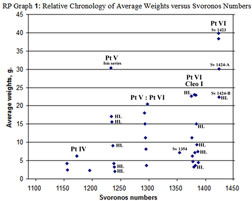Results from Comparisons of RP Graph 1 with F&L Table 3
In several different ways, RP Graph 1 corrects the attributions given in the invalid F&L Table 3: (1) The earliest known coins to contain high percentages of lead were produced in the time of Ptolemy V (204-180 BC), not after 180 BC in the times of Ptolemy VI and Ptolemy VIII; (2) the Zeus-Ammon/double eagle coins Sv1423, Sv1424-A and Sv1424-B were not markers of the same denomination produced over widely different times after 204 BC; and (3) a comparison of the size (diameter in millimeters) of coins produced after 180 BC with their Svoronos numbers shows that denominational marking by obverse and/or reverse types did not occur.
Firstly, RP Graph 1 shows results related to the metallic composition of the coins; superimposed near many of the data points are indications of coin composition (HL = High Lead) where examples of these coins have been found with high percentages of lead (the data is from F&L Appendix 3, pp. 69-72). For example, RP Graph 1 shows that the HL “Isis Series” of Ptolemy V was produced earlier than coins of Ptolemy VI (with co-regent Cleopatra I) that began in 180 BC. F&L Table 3 distributes the Isis coins piecemeal into three different periods of time (6b, 6c and 7c) beginning c.205 BC and possibly ending as late as 146 BC.
Because three Isis series coins (Sv 1235, 1239, 1240) “revealed high lead content consistent with Series 7a and 7b” and were “unmarked” they were placed into F&L series 7c (that does not appear in F&L Tables 2 and 3). F&L state that Series 7c possibly “did not commence until [after 146 BC]”, i.e., in the time of Ptolemy VIII. However, with their high lead content the three Isis series coins should not have been displaced from their universal assignment to Ptolemy V (204-180 BC); they belong together (as in RP Graph 1) with other unmarked Isis coins of Ptolemy V (Sv1234, Sv1236) that have the identical obverse/reverse as well as high percentages of lead.
Five of the seven examples of coins in the Pt V Isis Series column have high lead concentrations (15.6% to 33.3%). It has previously been accepted that the earliest examples of Ptolemaic bronze coins known to contain high percentages of lead were those attributed to Ptolemy VI (i.e., after 180 BC). As shown by HL in RP Graph 1, it now has become clear that, rather than as late as 146 BC as suggested by F&L, it was at least in the time of Ptolemy V (204-180 BC) that adulteration of bronze coinage with relatively inexpensive lead was initiated, apparently to reduce the cost of production and to increase the money supply during this especially difficult period in Ptolemaic history.
Secondly, in their erroneous F&L Table 3, F&L took six Zeus-Ammon/double eagle coins, and one single-eagle coin Sv1375 (22g), as the same denomination; this includes Sv1423 (38g) said to be produced by Ptolemy IV (c.204 BC in series 6a and 6b), Sv1424-A (30g) (in series 6c), and Sv1424-B (22g) in series 7c (said to be possibly after c.146 BC in the time of Ptolemy VIII). However, as shown in RP Graph 1, these coins are simply three different denominations that began production 180-c.170 in the time of Ptolemy VI. F&L have recently abrogated the assigning of these coins before 180 BC and they should consequently now be returned to their classical chronology as different denominations of Ptolemy VI after 180 BC. For a review of the various assignments of these coins, Click -
Click Re-attributions of the two-eagle coins of Ptolemy VI
Thirdly, between weight and related size, the more important element that determines denominational value is size. Using Svoronos sizes as indicating denominations, a table (developed below) of diameters and Svoronos' sizes gives a general view of second century BC coinage after 180 BC. This involves putting together the major coins of the second century, i.e., the two-eagle coins Sv1423-8, together with coins listed in F&L's Table of Hoards. A comparison of diameters using Svoronos sizes shows that five of the seven denominations of Sv1423-8 and Sv1375-87 circulated together in 180-c.145 BC each with two, or more, different obverse types, i.e., the same denomination had two, even three, different obverses. It is thereby again shown, in a different way, that there was no policy of denominational marking by obverse and/or reverse types: In the third, second, and first century BC, denominations were determined by weight and corresponding size. Click -
Click Comparisons of sizes and obverses for Ptolemaic bronze coins produced in 180-c.145 BC
Finally, click below for a summary of results and conclusions.
